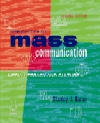Stanley J. Baran
| aggressive cues model | of media violence; media portrayals can indicate that certain classes of people are acceptable targets for real-world aggression
|
 |
 |
 |
| catharsis | theory that watching mediated violence reduces peopleís inclination to behave aggressively
|
 |
 |
 |
| causal relationships | the direct impact of one or more variables on one or more other variables
|
 |
 |
 |
| content analysis | the objective, systematic, and quantitative description of the content of communication
|
 |
 |
 |
| control group | subjects in an experiment who do not encounter the independent variable
|
 |
 |
 |
| correlation | the strength of relationship between two or more variables
|
 |
 |
 |
| dependent variable | phenomenon whose change as a result of manipulation of the independent variable is measured
|
 |
 |
 |
| desensitization | the idea that viewers become more accepting of real-world violence because of its constant presence in television fare
|
 |
 |
 |
| early window | the idea that media give children a window on the world before they have the critical and intellectual ability to judge what they see
|
 |
 |
 |
| environmental incentives | in social learning theory, the notion that real-world incentives can lead observers to ignore negative vicarious reinforcement
|
 |
 |
 |
| error term | see margin of error
|
 |
 |
 |
| estimated sampling error | see margin of error
|
 |
 |
 |
| ethnographic research | naturalistic examinations of audiences in specific and natural places
|
 |
 |
 |
| experimental conditions | the groups in an experiment who are confronted with variations in the independent variable
|
 |
 |
 |
| experiments | a research method where the manipulation of variables is employed to demonstrate the presence of causal relationships
|
 |
 |
 |
| field experiment | experiment conducted in subjectsí actual environments in the course of normal social events
|
 |
 |
 |
| generalizability | the question of applying demonstrated causal relationships to the larger, real-world environment
|
 |
 |
 |
| Hawthorne effect | when participation per se in an experiment alters subjectsí behavior
|
 |
 |
 |
| historical research | objective examination of phenomena in their own time
|
 |
 |
 |
| independent variable | the phenomenon that is altered or varied in an experiment
|
 |
 |
 |
| margin of error | the predictable and built-in level of error that accompanies all samples of a given size
|
 |
 |
 |
| natural experiment | see field experiment
|
 |
 |
 |
| oppositional decoding | interpreting media content in a manner counter to its apparent intent
|
 |
 |
 |
| participant-observer research | studies where the researcher ìjoinsî a group or enters a setting and, while participating in its ongoing activities, chronicles those activities and the interactions surrounding them
|
 |
 |
 |
| participants | the subjects in an experiment
|
 |
 |
 |
| phenomenology | study of media content as it is, as it exists
|
 |
 |
 |
| population | in survey research, the group under scrutiny to which the results obtained from a sample are generalized
|
 |
 |
 |
| primary sources | in historical research, material contemporary to the object under investigation
|
 |
 |
 |
| qualitative research | research that examines aspects of the mass communication process in their natural contexts
|
 |
 |
 |
| random sample | a sample in which each member of a group has an equal chance of inclusion
|
 |
 |
 |
| research | the objective search for knowledge
|
 |
 |
 |
| respondents | participants in a survey
|
 |
 |
 |
| sample | in survey research, respondents drawn from the population who are considered representative of that population
|
 |
 |
 |
| secondary sources | in historical research, reports and material produced after the period in question that bear on it
|
 |
 |
 |
| stereotyping | application of a standardized image or conception applied to members of certain groups, usually based on limited information
|
 |
 |
 |
| stimulation model | of media violence; viewing mediated violence can increase the likelihood of subsequent aggressive behavior
|
 |
 |
 |
| stratified random sample | in survey research, dividing a population according to some important characteristic before each division is randomly sampled
|
 |
 |
 |
| survey | a research method used to describe phenomena and their relationships in the actual environment at a given time
|
 |
 |
 |
| unobtrusive observer | in ethnomethodological research, a researcher who is present at and observing a situation but who does not intrude on it
|
 |
 |
 |
| vicarious reinforcement | in social learning theory, the observation of reinforcement operates in the same manner as actual reinforcement
|
 |
 |
 |
| willing suspension of disbelief | audience practice of willingly accepting the content before them as real
|



 2002 McGraw-Hill Higher Education
2002 McGraw-Hill Higher Education